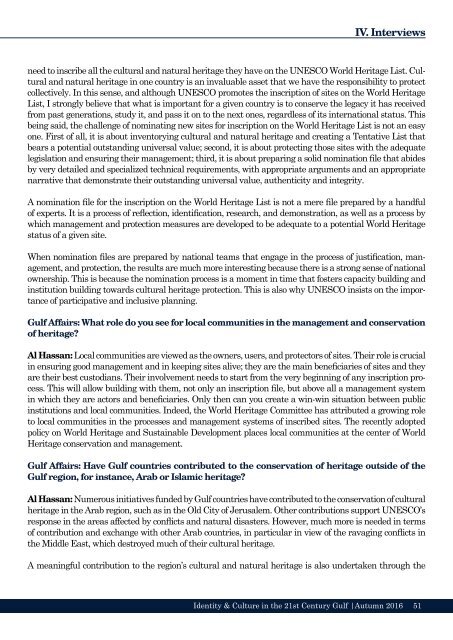You also want an ePaper? Increase the reach of your titles
YUMPU automatically turns print PDFs into web optimized ePapers that Google loves.
IV. Interviews<br />
need to inscribe all the cultural and natural heritage they have on the UNESCO World Heritage List. Cultural<br />
and natural heritage in one country is an invaluable asset that we have the responsibility to protect<br />
collectively. In this sense, and although UNESCO promotes the inscription of sites on the World Heritage<br />
List, I strongly believe that what is important for a given country is to conserve the legacy it has received<br />
from past generations, study it, and pass it on to the next ones, regardless of its international status. This<br />
being said, the challenge of nominating new sites for inscription on the World Heritage List is not an easy<br />
one. First of all, it is about inventorying cultural and natural heritage and creating a Tentative List that<br />
bears a potential outstanding universal value; second, it is about protecting those sites with the adequate<br />
legislation and ensuring their management; third, it is about preparing a solid nomination file that abides<br />
by very detailed and specialized technical requirements, with appropriate arguments and an appropriate<br />
narrative that demonstrate their outstanding universal value, authenticity and integrity.<br />
A nomination file for the inscription on the World Heritage List is not a mere file prepared by a handful<br />
of experts. It is a process of reflection, identification, research, and demonstration, as well as a process by<br />
which management and protection measures are developed to be adequate to a potential World Heritage<br />
status of a given site.<br />
When nomination files are prepared by national teams that engage in the process of justification, management,<br />
and protection, the results are much more interesting because there is a strong sense of national<br />
ownership. This is because the nomination process is a moment in time that fosters capacity building and<br />
institution building towards cultural heritage protection. This is also why UNESCO insists on the importance<br />
of participative and inclusive planning.<br />
Gulf Affairs: What role do you see for local communities in the management and conservation<br />
of heritage?<br />
Al Hassan: Local communities are viewed as the owners, users, and protectors of sites. Their role is crucial<br />
in ensuring good management and in keeping sites alive; they are the main beneficiaries of sites and they<br />
are their best custodians. Their involvement needs to start from the very beginning of any inscription process.<br />
This will allow building with them, not only an inscription file, but above all a management system<br />
in which they are actors and beneficiaries. Only then can you create a win-win situation between public<br />
institutions and local communities. Indeed, the World Heritage Committee has attributed a growing role<br />
to local communities in the processes and management systems of inscribed sites. The recently adopted<br />
policy on World Heritage and Sustainable Development places local communities at the center of World<br />
Heritage conservation and management.<br />
Gulf Affairs: Have Gulf countries contributed to the conservation of heritage outside of the<br />
Gulf region, for instance, Arab or Islamic heritage?<br />
Al Hassan: Numerous initiatives funded by Gulf countries have contributed to the conservation of cultural<br />
heritage in the Arab region, such as in the Old City of Jerusalem. Other contributions support UNESCO’s<br />
response in the areas affected by conflicts and natural disasters. However, much more is needed in terms<br />
of contribution and exchange with other Arab countries, in particular in view of the ravaging conflicts in<br />
the Middle East, which destroyed much of their cultural heritage.<br />
A meaningful contribution to the region’s cultural and natural heritage is also undertaken through the<br />
<strong>Identity</strong> & <strong>Culture</strong> in the 21st Century Gulf |Autumn 2016 51


